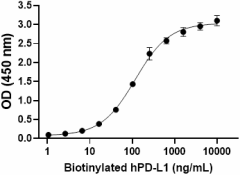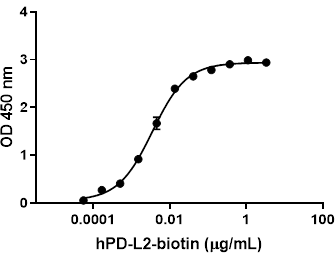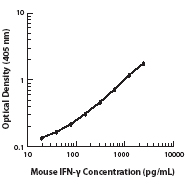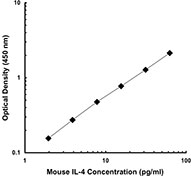- Regulatory Status
- RUO
- Other Names
- CD274, Programmed cell death 1 ligand 1 (PD-L1), B7 homolog 1 (B7h1)
- Ave. Rating
- Submit a Review

| Cat # | Size | Price | Quantity Check Availability | Save | ||
|---|---|---|---|---|---|---|
| 561104 | 25 µg | £281 | ||||
| 561106 | 100 µg | £565 | ||||
PD-L1 is a type I transmembrane protein of 290 amino acids, and it is a member of the B7 family. Human PD-L1 has 70% amino acid identity to its mouse orthologue. Binding of PD-L1 to its receptor PD-1 leads to the inhibition of T cell receptor–mediated lymphocyte proliferation and cytokine secretion. PD-L1 induces IL-10 production in T cells stimulated with low levels of anti-CD3. PD-L1/PD-1 interaction suppresses immune responses against autoantigens and tumors and plays an important role in the maintenance of peripheral immune tolerance. Disruption of the PD-L1 gene leads to up-regulated T cell responses and the generation of self-reactive T cells. Antibodies against PD-1 or PD-L1 leads to increased antitumor immunity. PD-L1 has an important role in conferring fetomaternal tolerance in an allogeneic pregnancy model; antibodies against PD-L1 lead to a breakdown in maternal tolerance to the fetus. PD-L1 shares its receptor with PD-L2 (CD273, B7-DC). PD-L2 has a more limited expression than PD-L1, being expressed on activated macrophages and dendritic cells. PD-L1 is expressed in many tumors, and the interaction with its receptor activates signaling pathways that inhibit T-cell activity and therefore the antitumor immune response. Antibodies targeting PD-1 or PD-L1 block the PD-1 pathway and reactivate T cell activity.
Product DetailsProduct Details
- Source
- Biotinylated recombinant human PD-L1, amino acid (Phe19-Arg238) (Accession # Q9NZQ7.1), with a linker (AAANSSLGS), a C-terminal human IgG1 (Pro100-Lys330) and an Avi-tag, was expressed in CHO cells. Human PD-L1-Avi tag was site-specifically biotinylated by enzyme BirA.
- Molecular Mass
- The 472 amino acid recombinant protein has a predicted molecular mass of approximately 53.7 kD. The DTT-reduced and non-reduced protein migrates at approximately 70 kD and 140 kD by SDS-PAGE, respectively. The predicted N-terminal amino acid is Phe.
- Purity
- > 95%, as determined by Coomassie stained SDS-PAGE.
- Formulation
- 0.22 µm filtered protein solution is in PBS, 5% glycerol
- Endotoxin Level
- Less than 0.1 EU per µg cytokine as determined by the LAL method.
- Concentration
- 25 µg size is bottled at 200 µg/mL. 100 µg size and larger sizes are lot-specific and bottled at the concentration indicated on the vial. To obtain lot-specific concentration and expiration, please enter the lot number in our Certificate of Analysis online tool.
- Storage & Handling
- Unopened vial can be stored between 2°C and 8°C for up to 2 weeks, at -20°C for up to six months, or at -70°C or colder until the expiration date. For maximum results, quick spin vial prior to opening. The protein can be aliquoted and stored at -20°C or colder. Stock solutions can also be prepared at 50 - 100 µg/mL in appropriate sterile buffer, carrier protein such as 0.2 - 1% BSA or HSA can be added when preparing the stock solution. Aliquots can be stored between 2°C and 8°C for up to one week and stored at -20°C or colder for up to 3 months. Avoid repeated freeze/thaw cycles.
- Activity
- Biotinylated recombinant human PD-L1 binds to immobilized recombinant human PD-1-Fc Chimera (Cat. No. 785102) in a dose-dependent manner. ED50 of this binding is 30 - 300 ng/mL.
- Application
-
Bioassay
- Application Notes
-
BioLegend carrier-free recombinant proteins provided in liquid format are shipped on blue-ice. Our comparison testing data indicates that when handled and stored as recommended, the liquid format has equal or better stability and shelf-life compared to commercially available lyophilized proteins after reconstitution. Our liquid proteins are validated in-house to maintain activity after shipping on blue ice and are backed by our 100% satisfaction guarantee. If you have any concerns, contact us at tech@biolegend.com.
Antigen Details
- Structure
- Disulfide bond-linked homodimer
- Distribution
-
APC, monocytes, dendritic cells, expressed in nonlymphoid tissues, and stromal cell
- Function
- Enhances CD28-independent T-helper cell function, suppresses immune responses against autoantigens, and participates in fetomaternal tolerance
- Interaction
- Antigen-stimulated T and B cells, regulatory T cells, follicular T and B cells, dendritic cells, and monocytes
- Ligand/Receptor
- PD-1 (CD279)
- Bioactivity
- Biotinylated recombinant human PD-L1 binds to immobilized recombinant human PD-1-Fc Chimera (Cat. No. 785102) in a dose-dependent. ED50 of this binding is 30 - 300 ng/mL.
- Cell Type
- Antigen-presenting cells, Dendritic cells, Monocytes
- Biology Area
- Cell Proliferation and Viability, Immuno-Oncology, Immunology
- Molecular Family
- CD Molecules
- Antigen References
-
- Dong H, et al. 1999. Nat Med. 5:1365-9.
- Freeman GJ, et al. 2000. J Exp Med. 192:1027-34.
- Latchman Y, et al. 2001. Nat Immunol. 2:261-8.
- Latchman YE, et al. 2004. Proc Natl Acad Sci U S A. 101:10691-6.
- Guleria I, et al. 2005. J Exp Med. 202:231-7.
- Lin DY, et al. 2008. Proc Natl Acad Sci U S A. 105:3011-6.
- Dai S, et al. 2014. Cell Immunol. 290:72-9.
- Melero I, et al. 2015. Nat Rev Cancer. 15:457-72.
- Gene ID
- 29126 View all products for this Gene ID
- UniProt
- View information about PD-L1 on UniProt.org

 Login / Register
Login / Register 
























Follow Us